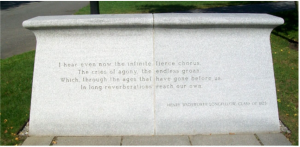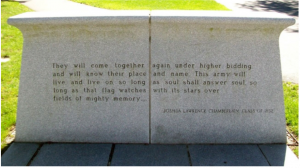Across from the Gibson Music Hall of Bowdoin College stands a war memorial that honors one hundred and eleven Bowdoin students who served and died while fighting for the United States in various conflicts: World War II, the Korean conflict, and the Vietnam War. Erected in stone, the monument is comprised of three installations of granite that are sculpted into sturdy, two foot high walls, which frame a stone seating area. The design of this monument aims to generate a refuge where passersby can come not to grieve but to reflect and heal from the tragedies of these wars. The center wall contains the inscribed one hundred and eleven names listed under their corresponding conflict, which is framed by two identical stone walls that each contain a quote from a prominent man in both Bowdoin and American history.
The Northern facing wall contains an inscription that comes from one of Henry Longfellow’s works called “The Arsenal at Springfield.” The quote draws attention to the pain and suffering brought on by war.
“I hear even now the infinite fierce chorus.
The cries of agony, the endless groan.
Which, through the ages that have gone before us.
In long reverberations reach our own”
Henry Wadsworth Longfellow, Class of 1825
Meanwhile the Southern facing wall holds an inscription by Joshua Chamberlain that suggests slain soldiers, in this case Bowdoin students, can find peace for an eternity in a heavenly embrace. This quote originates from one of his published works called The Passing Armies, which details the closing acts of the Civil War from the perspective of a soldier in the 5th Corps.
“They will come together again under
higher bidding and will know their place
and name. This army will live and live
on so long as soul shall answer soul, so
long as that flag watches with its stars
over fields of mighty memory…”
Joshua Lawrence Chamberlain, Class of 1852
Although it is important to consider the meaning of the inscriptions, perhaps more salient is instead who wrote the the message. Both Chamberlain and Longfellow were graduates of Bowdoin College, which the institution included on the monument’s inscription; however, beyond Bowdoin these men became significant, outstanding members of American society.
Henry Longfellow was the most famous American poet of the 19th century. He is most well known for writing “Paul Revere’s Ride” as well as being the first American to translate Dante Alighieri’s Divine Comedy. Meanwhile, Chamberlain was known as a successful and brave General from the U.S. Civil War; he was integral in securing a Union victory in the Battle of Gettysburg and was selected by General Ulysses S. Grant to accept the Confederacy’s surrender at Appomattox. Furthermore, Chamberlain was a well-known local hero who was served as the College President of Bowdoin for twelve years (1871-1883). His family plot can be found in the local Brunswick cemetery, the same town Bowdoin College is situated in.
Therefore, by including quotes by Chamberlain and Longfellow, Bowdoin is attempting to associate their achievements with the college. This idea is corroborated by the the college’s decision to include Chamberlain and Longfellow’s respective class years. In context with the monument, Bowdoin validates the contributions of the tragically lost students through the accomplishments of prominent men of history who have strong Bowdoin connections. Therefore, these inscriptions are utilized by the college to connect Bowdoin alumni to broader American history, which consequently portrays the college itself as one of historical prominence.
References:
Biography. (2015) “Joshua Chamberlain Biography.” Biography. Accessed May 15, 2021, https://www.biography.com/political-figure/joshua-chamberlain
Fischer, William (2011). “Bowdoin College War Memorial.” The Historical Marker Database. Accessed May 2, 2021, https://www.hmdb.org/m.asp?m=55495
Memorial Committee (1990). “Scope of the Memorial: A Statement Prepared by the Memorial Committee” Bowdoin Special Collections.
Poetry Foundation. “Henry Wadsworth Longfellow” Accessed May 15, 2021, https://www.poetryfoundation.org/poets/henry-wadsworth-longfellow


